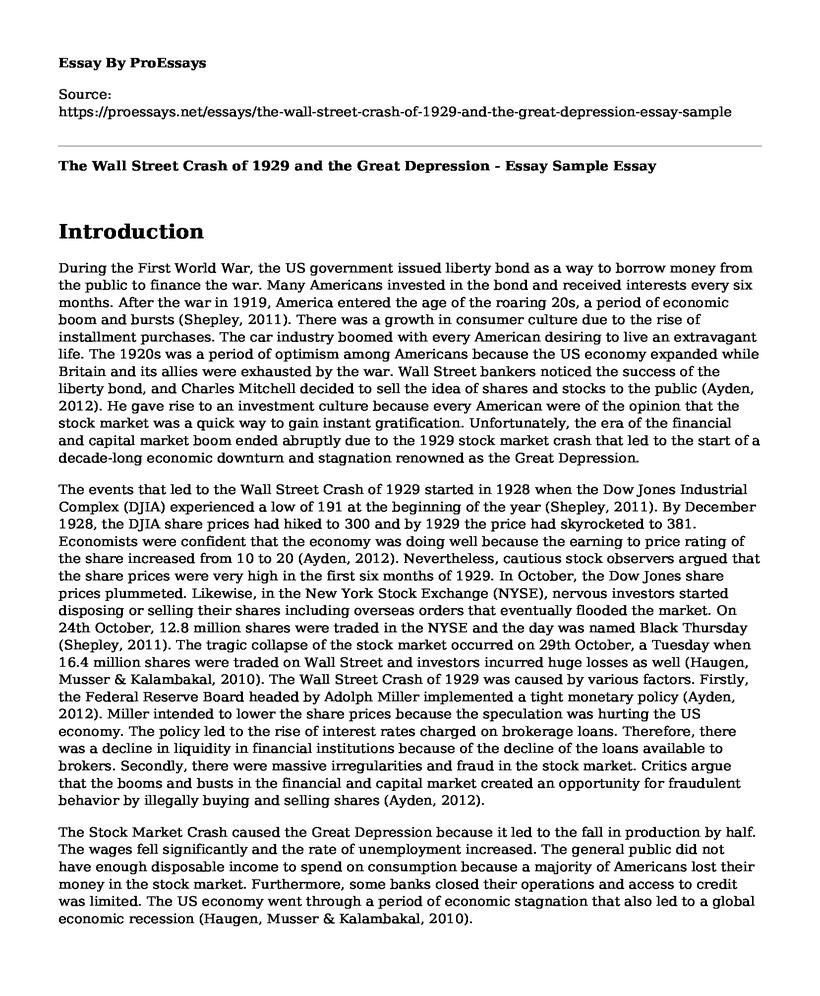Introduction
During the First World War, the US government issued liberty bond as a way to borrow money from the public to finance the war. Many Americans invested in the bond and received interests every six months. After the war in 1919, America entered the age of the roaring 20s, a period of economic boom and bursts (Shepley, 2011). There was a growth in consumer culture due to the rise of installment purchases. The car industry boomed with every American desiring to live an extravagant life. The 1920s was a period of optimism among Americans because the US economy expanded while Britain and its allies were exhausted by the war. Wall Street bankers noticed the success of the liberty bond, and Charles Mitchell decided to sell the idea of shares and stocks to the public (Ayden, 2012). He gave rise to an investment culture because every American were of the opinion that the stock market was a quick way to gain instant gratification. Unfortunately, the era of the financial and capital market boom ended abruptly due to the 1929 stock market crash that led to the start of a decade-long economic downturn and stagnation renowned as the Great Depression.
The events that led to the Wall Street Crash of 1929 started in 1928 when the Dow Jones Industrial Complex (DJIA) experienced a low of 191 at the beginning of the year (Shepley, 2011). By December 1928, the DJIA share prices had hiked to 300 and by 1929 the price had skyrocketed to 381. Economists were confident that the economy was doing well because the earning to price rating of the share increased from 10 to 20 (Ayden, 2012). Nevertheless, cautious stock observers argued that the share prices were very high in the first six months of 1929. In October, the Dow Jones share prices plummeted. Likewise, in the New York Stock Exchange (NYSE), nervous investors started disposing or selling their shares including overseas orders that eventually flooded the market. On 24th October, 12.8 million shares were traded in the NYSE and the day was named Black Thursday (Shepley, 2011). The tragic collapse of the stock market occurred on 29th October, a Tuesday when 16.4 million shares were traded on Wall Street and investors incurred huge losses as well (Haugen, Musser & Kalambakal, 2010). The Wall Street Crash of 1929 was caused by various factors. Firstly, the Federal Reserve Board headed by Adolph Miller implemented a tight monetary policy (Ayden, 2012). Miller intended to lower the share prices because the speculation was hurting the US economy. The policy led to the rise of interest rates charged on brokerage loans. Therefore, there was a decline in liquidity in financial institutions because of the decline of the loans available to brokers. Secondly, there were massive irregularities and fraud in the stock market. Critics argue that the booms and busts in the financial and capital market created an opportunity for fraudulent behavior by illegally buying and selling shares (Ayden, 2012).
The Stock Market Crash caused the Great Depression because it led to the fall in production by half. The wages fell significantly and the rate of unemployment increased. The general public did not have enough disposable income to spend on consumption because a majority of Americans lost their money in the stock market. Furthermore, some banks closed their operations and access to credit was limited. The US economy went through a period of economic stagnation that also led to a global economic recession (Haugen, Musser & Kalambakal, 2010).
Conclusion
In conclusion, the US economy underwent a period of economic expansion in the 1920s referred to as the Golden or Roaring 20s. There was an increase in consumer expenditure and a growth in the investment culture. The booms and bursts in the financial and capital markets presented opportunities for economic prosperity for every economy. However, the period of great economic performance was cut short by the stock market crash leading to the Great Depression.
References
Ayden, E. (2012). The Stock Market Crash of the Great Recession: Who's To Blame?. Journal Of Stock & Forex Trading, 01(01). http://dx.doi.org/10.4172/2168-9458.1000e103
Haugen, D., Musser, S., & Kalambakal, V. (2010). The Great Depression. Farmington Hills, MI: Greenhaven Press.
Shepley, N. (2011). The Roaring 20's and the Wall Street Crash. Luton: Andrews UK.
Cite this page
The Wall Street Crash of 1929 and the Great Depression - Essay Sample. (2022, May 16). Retrieved from https://proessays.net/essays/the-wall-street-crash-of-1929-and-the-great-depression-essay-sample
If you are the original author of this essay and no longer wish to have it published on the ProEssays website, please click below to request its removal:
- Essay on Lincoln and Colonization
- President Franklin D. Roosevelt Policies Effect During the Great Depression Essay
- Rome: Virgil and Ovid - Essay Sample
- Essay Example on American Civil War: Conflict that Shaped and Preserved the Nation
- Letter to John Adams by Abigail Adams Analysis Essay
- Essay Example on Dances With Wolves: A Journey of Love and Mutual Respect
- Essay Example on Troy Maxson: A Man of Strength, Hard Work, and Imagination







